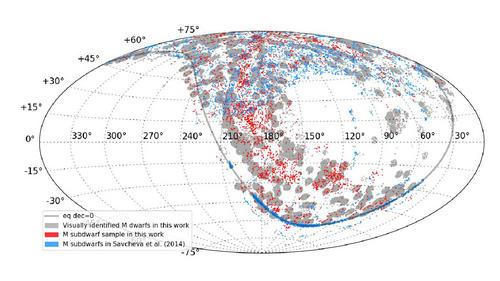An international team led by Prof. A-Li Luo of National Astronomical Observatories of Chinese Academy of Sciences (NAOC) modified the classification system of very low mass stars using more than 100 thousand visually inspected spectra from LAMOST data, and finally verified 2791 M subdwarfs in LAMOST Data Release 4. This work has been published online in Astrophysical Journal Supplement Series (2019, ApJS,240, 31).
M subdwarfs are Galactic fossils with lifetimes much longer than the Hubble time. They are rare in the solar neighborhood but supposed to be the largest stellar component of the Milky Way’s halo. Studies of M subdwarf spectra show that they are metal-poor objects compared with the common M dwarfs of near-solar metallicity, thus making them crucial touchstones of the star formation and metal enrichment histories of the Milky Way.
Up until now, the search for M subdwarfs has been limited to high Galactic latitude areas, favoring the detection of halo and thick disk objects. Whether or not a cool subdwarf population could be present in the Galactic thin disk, mixed (or not) with the immense M-dwarf population and having similar (or not) kinematic and dynamic properties, remains an open question. LAMOST data provide an excellent source to address this problem since this instrument is conducting the most complete spectroscopic survey of the Galactic disk and is especially targeted to the regions of the Galactic anti-center.
In order to search for spectroscopic cool subdwarfs from DR4 of the LAMOST regular survey, the Luo team reviewed the history of current classification system for M subdwarfs and suggested to modify the current classification system for more reliable classification results, especially for the early type M subdwarfs. The new system was established by more than 10 thousand visually inspected spectra from LAMOST data.
Using the revised schemes as filters and visual inspection as the final verification tool, the Luo team identified 2791 M subdwarfs from the entire LAMOST DR4, out of more than a million of spectra submitted to the screening. In this sample, 141 have detectable Hα emissions.
Miss Zhang and Mr. Wang at NAOC and French astronomer Georges Comte have contributed to this work as key co-authors. This work was supported by the National Basic Research Program of China, China Scholarship Council, and the National Natural Science Foundation of China.

Fig. LAMOST DR4 M subdwarfs in the Galactic coordinate system.

Address: 20A Datun Road, Chaoyang District, Beijing, China code: 100012
Tel: 010-64888708 E-mail: naoc@nao.cas.cn

